Writers' Treasure
Effective writing advice for aspiring writers

Creative Writing 101
Creative writing is any form of writing which is written with the creativity of mind: fiction writing, poetry writing, creative nonfiction writing and more. The purpose is to express something, whether it be feelings, thoughts, or emotions.
Rather than only giving information or inciting the reader to make an action beneficial to the writer, creative writing is written to entertain or educate someone, to spread awareness about something or someone, or to express one’s thoughts.
There are two kinds of creative writing: good and bad, effective and ineffective. Bad, ineffective creative writing cannot make any impression on the reader. It won’t achieve its purpose.
So whether you’re a novelist, a poet, a short-story writer, an essayist, a biographer or an aspiring beginner, you want to improve your craft. The question is: how?
When you write great fiction, poetry, or nonfiction, amazing things can happen. Readers can’t put it down. The work you wrote becomes a bestseller. It becomes famous. But you have to reach to that level… first .
The best way to increase your proficiency in creative writing is to write, write compulsively, but it doesn’t mean write whatever you want. There are certain things you should know first… it helps to start with the right foot.
To do exactly that, here we have a beginners’ guide from Writers’ Treasure on the subject:
- An Introduction to Creative Writing
- How to Get Started in Creative Writing in Just Three Steps
- Creative Writing vs. Technical Writing
- Fiction Writing 101: The Elements of Stories
- Poetry Writing: Forms and Terms Galore
- Creative Non-Fiction: What is it?
- Tips and Tricks to Improve Your Creative Writing
- Common Mistakes Made by Creative Writers
For novelists: do you want to write compelling opening chapters?
Are you an aspiring novelist? Will your novel see the light of day? For that, you will need to make the first chapter of your story as compelling as possible. Otherwise, readers won’t even pick up your novel. That chapter can be the make-or-break point that decides whether your novel is published or not. It’s because good editors know how you write from the first three pages… or sometimes even from the opening lines.
To solve this problem, I created a five-part tutorial on Writing Compelling Opening Chapters . It outlines why you need to write a compelling opening chapter, my personal favourite way of beginning it, what should be told and shown in it, general dos and don’ts, and what you need to do after having written it. Check it out for more.
Need more writing tips?
Sometimes you reach that stage when you outgrow the beginner stage of writing but feel that you’re not yet an expert. If I just described you, no worries– Writers’ Treasure’s writing tips are here. Whether you want to make your writing more readable, more irresistible, more professional, we’ve got you covered. So check out our writing tips , and be on your way to fast track your success.
I offer writing, editing and proofreading , as well as website creation services. I’ve been in this field for seven years, and I know the tools of the trade. I’ve seen the directions where the writing industry is going, the changes, the new platforms. Get your work done through me, and get fast and efficient service. Get a quote .
Free updates
Get free updates from Writers’ Treasure and learn more tips and tricks to improve your writing.
Share this:
52 thoughts on “creative writing 101”.
- Pingback: Creative Non-Fiction: What is it? | Writers Treasure
- Pingback: Poetry Writing Forms and Terms | Writers Treasure
- Pingback: Fiction Writing Tips and Elements to focus on | Writers Treasure
- Pingback: Creative Writing vs. Technical Writing | Writers Treasure
- Pingback: How to Get Started in Creative Writing | Writers Treasure
- Pingback: An Introduction to Creative Writing | Writers Treasure
- Pingback: How to Improve Your Creative Writing | Writers Treasure
- Pingback: Common Mistakes Made by Creative Writers | Writers Treasure
- Pingback: To Outline or Not to Outline, That is the Question
- Pingback: How to Create Effective Scenes and Chapters in Your Novel : Writing Forward
- Pingback: Writing Powerful True Short Stories
- Pingback: POV: What it is and how it matters
- Pingback: Creative Writing Skills: Do You Have Them All?
- Pingback: Three great articles check out on the Writers Treasure - Jamie Folsom
- Pingback: Warning: Do You Know that Your Paragraphs are Not Good Enough?
- Pingback: Welcome to Writers Treasure
- Pingback: How to Create Effective Scenes and Chapters in Your Novel
- Pingback: Adding Humour to Creative Write-up: Tips and Tricks
- Pingback: Creative Writing vs. Resume Writing | Resume Matrix
- Pingback: How to Get Started in Creative Writing in Just Three Steps | Blog do Learning
- Pingback: The #1 writing advice: write the truth
- Pingback: Creative writing in 2015: here’s what you need to know
- Pingback: Creative Writing Can Be Practical Writing - Simple Writer
- Pingback: Freedom Friday: Liberating Your Creativity | Renee "Soul Writer" Brooks
- Pingback: Tips to help you become a good copywriter | The Creative Copywriter.
- Pingback: Creative Writing | Shahad Almarzooq
- Pingback: How to be good at creative writing?
- Pingback: Learn creative writing
- Pingback: Creative Writing - Occident Books
- Pingback: How to become an outstanding writer
- Pingback: 5 creative writing tips to help you write great essays! – Essay Writing Tips and Help
- Pingback: Creative Writing Tips | learningland2016
- Pingback: NELTA ELT Forum
- Pingback: Language, Communication and Creativity. – lookinglanguage
- Pingback: Keep Your Kids Learning Even When School Year Is Over | Severna Park Children's Centre, Inc
- Pingback: 10 Free Online Courses on Creative Writing » A guide to free online courses
- Pingback: How to start a successful Blog – Beginner’s Guide for 2016
- Pingback: How to start a successful Blog – Beginner’s Guide for 2017
- Pingback: Best of English classes | Site Title
- Pingback: English Classes,Which Classes Dominate others? – Pressing Times
- Pingback: Creative Writing 101 | Junctionway
- Pingback: How to Write Quality Articles: A New Guide for Online Startups [Part Two: 3 Simple Ways for Finding Ideas] - Suhaib Mohammed
- Pingback: Writing Blogs in the Shower - Say It For You- Say It For You
- Pingback: 5 Ways To Improve Your Health First In The New Year - Sarah Scoop
- Pingback: 10 Hobbies Your Teen Can Get as an Alternative to Digital Devices While on Lockdown | meekscutoff.com
- Pingback: 50+ Easy Fiverr Freelance Jobs Examples to Start Today! | IsuaWealthyPlace
- Pingback: 10 Creative Writing Strategies In The Composition Classroom - Wizpals
- Pingback: 5 Ways to Become the MacGyver of Creative Writing
- Pingback: Balancing Your Life As A Writer And Head Of The Family - ebookomatic.com
- Pingback: EbookoMatic | Ricos Electronic World
- Pingback: 20 Types of Freelance Writing Careers (The Definitive List)
- Pingback: Welcome to Musings & Meanderings: A Journey Through Poetry and Prose - Musings & Meanderings
Comments are closed.
TRY OUR FREE APP
Write your book in Reedsy Studio. Try the beloved writing app for free today.
Craft your masterpiece in Reedsy Studio
Plan, write, edit, and format your book in our free app made for authors.

Guides • Perfecting your Craft
Last updated on Dec 23, 2022
Creative Writing: 8 Fun Ways to Get Started
About the author.
Reedsy's editorial team is a diverse group of industry experts devoted to helping authors write and publish beautiful books.
About Savannah Cordova
Savannah is a senior editor with Reedsy and a published writer whose work has appeared on Slate, Kirkus, and BookTrib. Her short fiction has appeared in the Owl Canyon Press anthology, "No Bars and a Dead Battery".
Creative writing is a written art form that uses the imagination to tell stories and compose essays, poetry, screenplays, novels, lyrics, and more. It can be defined in opposition to the dry and factual types of writing found in academic, technical, or journalistic texts.
Characterized by its ability to evoke emotion and engage readers, creative writing can tackle themes and ideas that one might struggle to discuss in cold, factual terms.
If you’re interested in the world of creative writing, we have eight fantastic exercises and activities to get you started.

1. Use writing prompts every week

Coming up with ideas for short stories can be challenging, which is why we created a directory of 1700+ creative writing prompts covering a wide range of genres and topics. Writing prompts are flexible in nature, they are meant to inspire you without being too constrictive. Overall, they are a great way to keep your creative muscles limber.
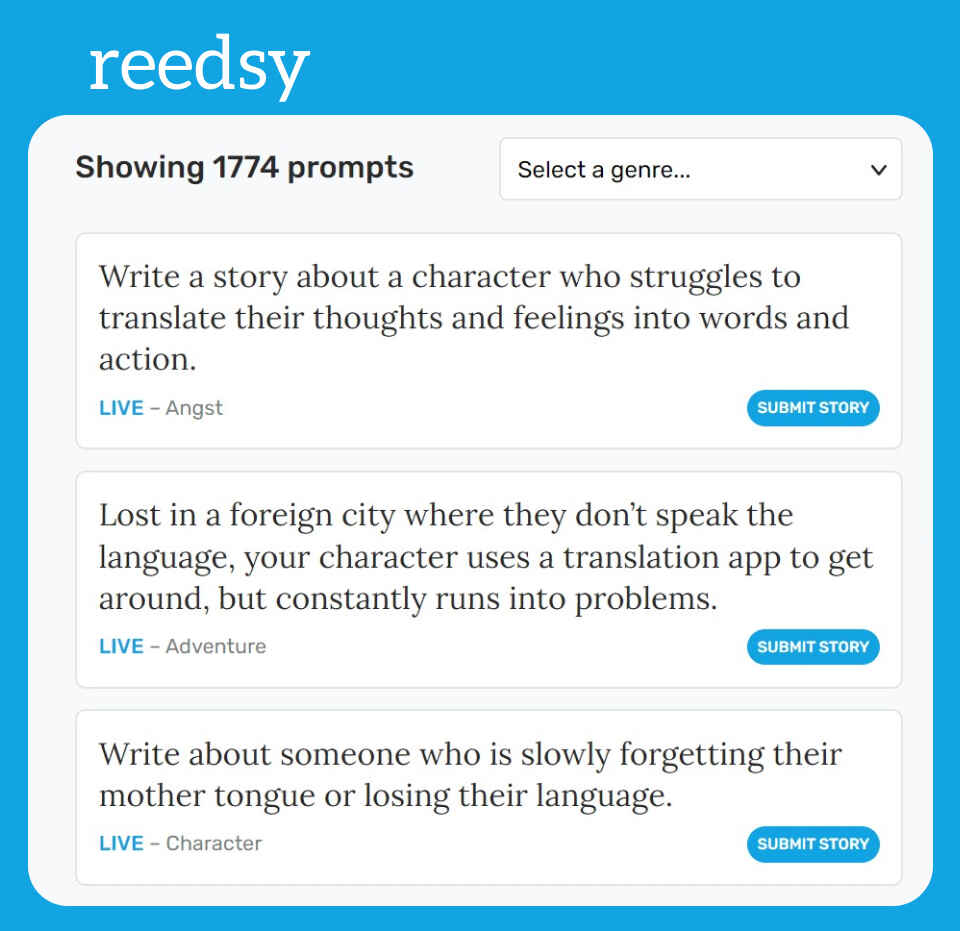
If you’re struggling for motivation, how does a hard deadline and a little prize money sound? Prompts-based writing contests are a fantastic way to dive into creative writing: the combination of due dates, friendly rivalries, prize money, and the potential to have your work published is often just what’s needed to propel you over the finish line.
We run a weekly writing contest over on Reedsy Prompts , where hundreds of writers from all around the world challenge themselves weekly to write a short story between 1,000 and 3,000 words for a chance to win the $250 prize. Furthermore, the community is very active in providing constructive feedback, support, and accountability to each other 一 something that will make your efforts even more worthwhile.
Take a peek at our directory of writing contests which features some of the most prestigious open writing competitions in the world.

2. Start journaling your days
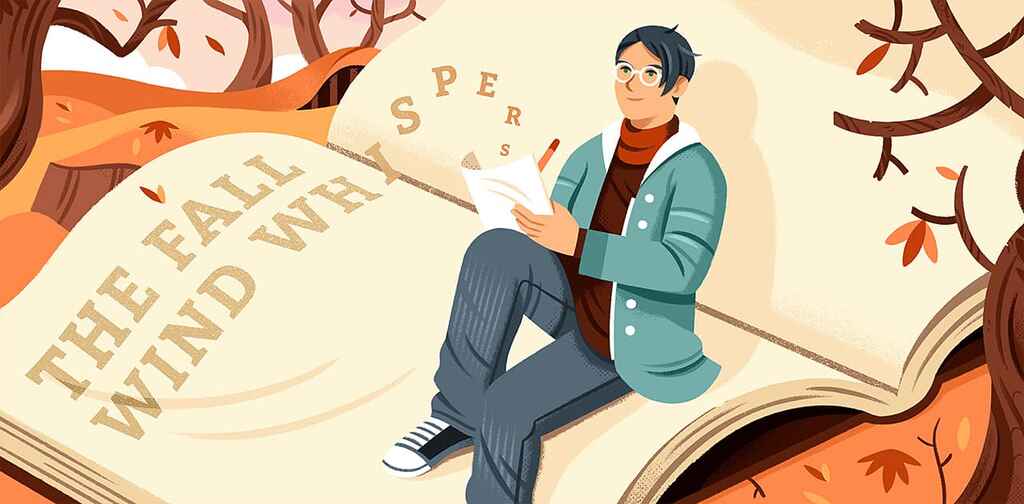
Another easy way to get started with creative writing is to keep a journal. We’re not talking about an hour-by-hour account of your day, but journaling as a way to express yourself without filters and find your ‘voice in writing’. If you’re unsure what to journal about, think of any daily experiences that have had an impact on you, such as…
Special moments . Did you lock yourself out of your house? Or did you catch a beautiful sunset on your way back from groceries? Capture those moments, and how you felt about them.
People . Did you have an unusual exchange with a stranger at the bar? Or did you reconnect with someone you haven’t seen in years? Share your thoughts about it.
World events . Is there something happening in the world right now that is triggering you? That’s understandable. You can reflect on it (and let some steam off) while journaling.
Memories . Did you go down memory lane after a glass of wine? Great, honor those memories by trying to recollect them in detail on paper so that they will always stay vivid in your mind.
Life decisions . Are you having an existential crisis about what to do with your life? Write down your thought process, and the pros and cons of the possible decisions in front of you. You’ll be surprised to discover that, not only is it a great creative writing exercise, but it can also actually help you sort your life out!
If you struggle to write consistently, sign up for our How to Write a Novel course to finish a novel in just 3 months.
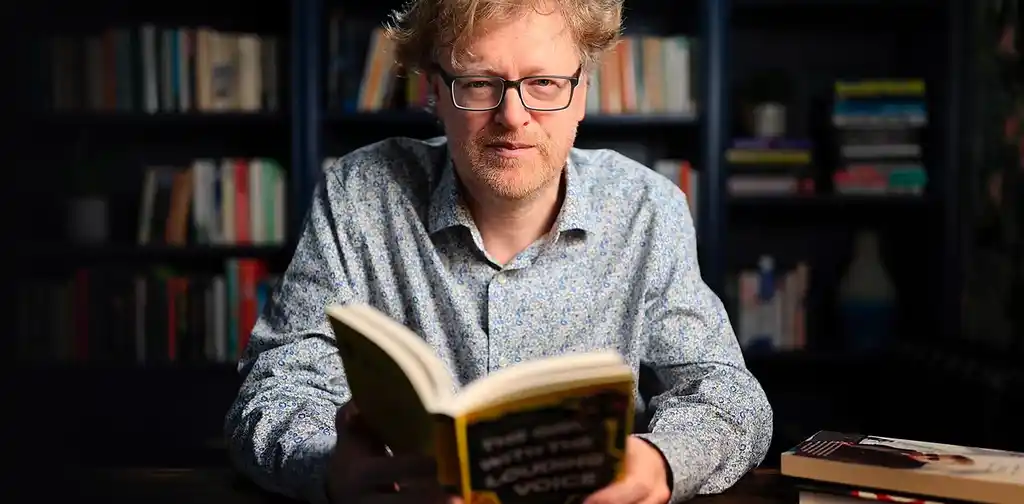
NEW REEDSY COURSE
How to Write a Novel
Enroll in our course and become an author in three months.
3. Create an anonymous social media account

Like anonymous blogging, an incognito Twitter account sidesteps the pressure that comes with attaching your name to your work. Anonymously putting tiny stories out into the ether gives you the freedom to create without worrying about the consequences — which is great, so long as you don’t use it as an opportunity to troll people or spread conspiracy theories.
You could use the anonymous account in different ways. For example, you could…
- Tweet from unique perspectives (e.g. a dog observing human behavior );
- Create a parody account of real or fictional people (e.g. an English poet from the Middle Ages );
- Challenge yourself to write tiny flash fiction stories that fit into Twitter threads.
Just remember, you’re not doing this to fool anyone into thinking that your account is real: be a good citizen and mark yourself a fiction account in your bio.
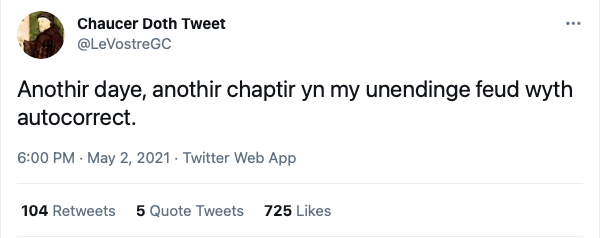
But if you’re not really a social media kinda person, you may enjoy our next tip, which is a bit more on the analog side.

GET ACCOUNTABILITY
Meet writing coaches on Reedsy
Industry insiders can help you hone your craft, finish your draft, and get published.
4. Find an old photo and tell its story
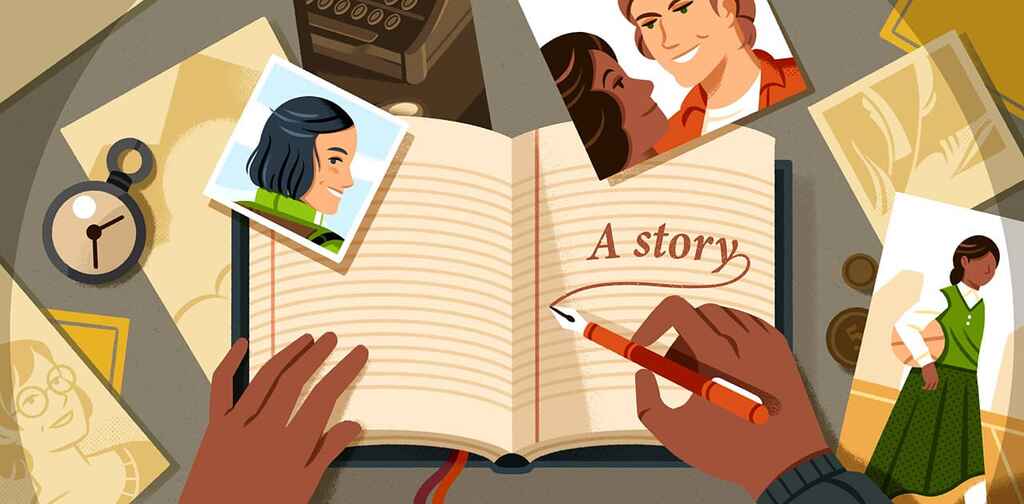
Find a random old photo — maybe on the web, maybe from a photo album in a yard sale — and see what catches your attention. Look closely at it and try to imagine the story behind it. What was happening? Who are the people in it and how are they really feeling? Do they share a relationship, and of what kind? What are their goals and dreams?
In other words, bring the photo to life with your imagination. Don't be afraid to take artistic license with your story, as the goal is to be creative and have fun while writing.
How do you know it’s creative writing?
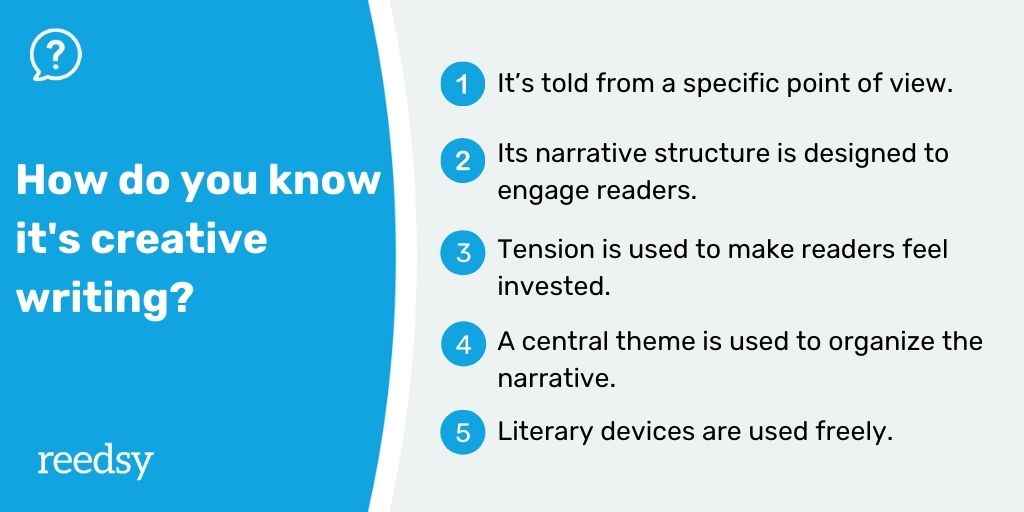
5. Create a character from a random name

Just as our universe started from a few simple elements, you can create a character from a few basic information, like their name, culture, and gender. Reedsy’s handy character name generator can help you with that, offering random names based on archetypes, Medieval roots, fantasy traits and more. A few examples? A Celtic heroine named Fíona O'Keefe, a hero’s sidekick named Aderine, or a Korean track star named Park Kang-Dae.
Once you've chosen their name, begin to develop their personality. Set a timer for 5–10 minutes and write anything that comes to mind about them. It could be a page from their FBI dossier, a childhood diary entry, or simply a scene about them boiling an egg.
Just ‘go with the flow’ and don’t stop writing until your time is up. Repeat the process a few times to further hone the personality. If you like what you end up with, you can always go deeper later by creating a character bible .
If a stream-of-consciousness exercise is not your thing, you can try to imagine your character in a specific situation and write down how’d they respond to it. For example, what if they were betrayed by a friend? Or if they were elected in power? To help you imagine situations to put your character in, we made a free template that you can download below.

FREE RESOURCE
Reedsy’s Character Questionnaire
40 questions to help you develop memorable characters.
6. Construct a character by people-watching

People watching is “the action of spending time idly observing people in a public place.” In a non-creepy way, ideally. Sit on a bench on a public square or on a road-side table at your favorite café, and start observing the people around you. Pay attention to any interesting quirks or behaviors, and write it down. Then put on your detective’s hat and try to figure out what that tells you about them.
For example, the man at the table next to you at the restaurant is reading the newspaper. His jacket and hat are neatly arranged next to him. The pages make a whipping sound as he briskly turns them, and he grimaces every time he reads a new article. Try to imagine what he’s reading, and why he’s reacting the way he is. Then, try to build a character with the information you have. It’s a fun creative exercise that will also, hopefully, help you better empathize with strangers.
7. “Map” something you feel strongly about into a new context

Placing your feelings into new contexts can be a powerful creative writing exercise. The idea is to start from something you feel strongly about, and frame it into a completely different context.
For example, suppose your heart is torn apart after you divorce your life-long partner: instead of journaling or crafting an entire novel about it, you could tell a story about a legendary trapeze duo whose partnership has come to an end. If you’re struggling with politicking and petty power dynamics at the office: what if you “mapped” your feelings onto an ant who resents being part of a colony? Directing your frustration at a queen ant can be a fun and cathartic writing experience (that won’t get you in trouble if your co-workers end up reading your story).
8. Capture the moment with a haiku

Haikus are poems from the Japanese tradition that aim to capture, in a few words, daily moments of insight (usually inspired by nature). In a nutshell, it’s about becoming mindful of your surroundings, and notice if you can see something in a new or deeper way 一 then use contrasting imagery to express whatever you noticed.
Here’s an example:
Bright orange bicycle
Speeding through the autumn leaves
A burst of color waves
It may sound a bit complicated, but it shouldn’t be 一 at least not for the purpose of this exercise. Learn the basics of haiku-writing , then challenge yourself to write one per day for a week or month. At the end, you’ll be able to look back at your collection of poems and 一 in the worst case scenario 一 revisit small but significant moments that you would have otherwise forgot about.
Creative writing can be any writing you put your heart and soul into. It could be made for the purpose of expressing your feelings, exploring an idea, or simply entertaining your readers. As you can see there’s many paths to get involved with it, and hundreds of exercises you can use as a starting point. In the next post , we’ll look more in detail at some creative writing examples from some fellow authors.
Join a community of over 1 million authors
Reedsy is more than just a blog. Become a member today to discover how we can help you publish a beautiful book.
Bring your stories to life
Our free writing app lets you set writing goals and track your progress, so you can finally write that book!

1 million authors trust the professionals on Reedsy. Come meet them.
Enter your email or get started with a social account:

COMMENTS
A beginner's guide to creative writing. Read it to know about the intro, how to get started, fiction writing, poetry writing, creative nonfiction, and more.
Creative Writing is the art of using words to express ideas and emotions in imaginative ways. It encompasses various forms including novels, poetry, and plays, focusing on narrative craft, …
Simply put, creative writing is any writing that falls outside of technical, journalistic, or academic writing. You can think of it as classic storytelling. It …
How to Boost Creativity and Improve Your Creative Writing. A creative writer strives to tell unique stories in a distinctive voice. Yet with all the fiction writing already out there in the world, it can be hard to feel that your …
Characterized by its ability to evoke emotion and engage readers, creative writing can tackle themes and ideas that one might struggle to discuss in cold, factual terms. If you’re interested in the world of creative writing, we …
Writing can help you explore deep questions, use your imagination, and express your thoughts and feelings in a healthy way. If you want to learn creative writing, you’ve come to the right place. Read on to learn our …